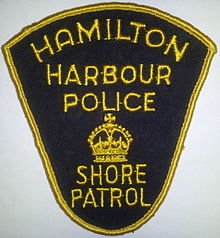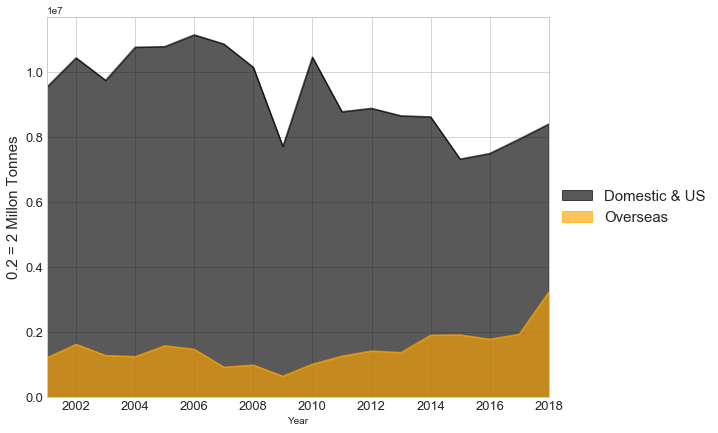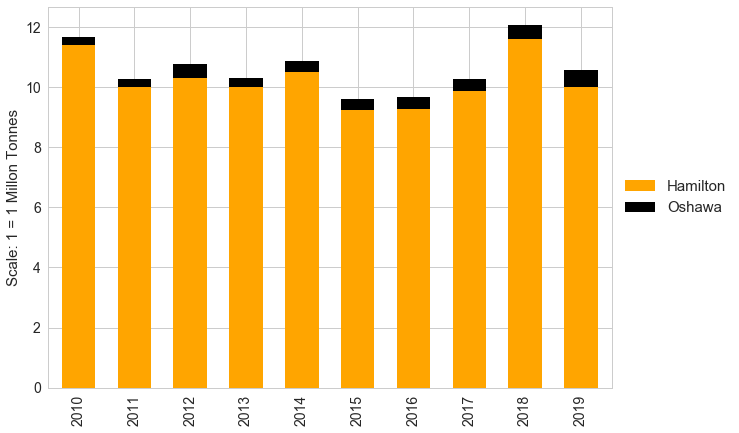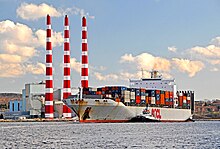
The St. Lawrence Seaway is a system of locks, canals, and channels in Canada and the United States that permits oceangoing vessels to travel from the Atlantic Ocean to the Great Lakes of North America, as far inland as Duluth, Minnesota, at the western end of Lake Superior. The seaway is named for the St. Lawrence River, which flows from Lake Ontario to the Atlantic Ocean. Legally, the seaway extends from Montreal, Quebec, to Lake Erie, and includes the Welland Canal. Ships from the Atlantic Ocean are able to reach ports in all five of the Great Lakes, via the Great Lakes Waterway.

A port is a maritime facility comprising one or more wharves or loading areas, where ships load and discharge cargo and passengers. Although usually situated on a sea coast or estuary, ports can also be found far inland, such as Hamburg, Manchester and Duluth; these access the sea via rivers or canals. Because of their roles as ports of entry for immigrants as well as soldiers in wartime, many port cities have experienced dramatic multi-ethnic and multicultural changes throughout their histories.

The modern terms short-sea shipping, marine highway, and motorways of the sea, and the more historical terms coastal trade, coastal shipping, coasting trade, and coastwise trade, all encompass the movement of cargo and passengers mainly by sea along a coast, without crossing an ocean.

The Port of Halifax comprises various port facilities in Halifax Harbour in Halifax, Nova Scotia, Canada. It covers 10 km2 (3.9 sq mi) of land, and looks after 150 km2 (58 sq mi) of water.

This article is about the Economy of Hamilton, Ontario.

Burlington Street is a partially at grade and elevated roadway in Hamilton, Ontario, stretching along the south shore of Hamilton Harbour in Lake Ontario. Burlington Street has four different statuses along the route. In its western terminus, it is a collector route ending at Bay Street North. Upon the intersection at Wellington Street, the road becomes an arterial route with four lanes. The Street ends at Parkdale Avenue. On October 14, 2015, city council approved the renaming of the upper portion of Burlington Street from 165 meters east of Ottawa St to the QEW to Nikola Tesla Boulevard.

The Port of Toronto is an inland port on the northwest shoreline of Lake Ontario in Toronto, Ontario, Canada. The port covers over 21 hectares of land on the eastern shore of the Toronto Harbour, in an area known as the Port Lands. The port includes several facilities, including Marine Terminal 51, Warehouse 52, and the International Marine Passenger Terminal. The Port of Toronto is operated by PortsToronto.
The Port of Vancouver is the largest port in Canada and the fourth largest in North America by tonnes of cargo, facilitating trade between Canada and more than 170 world economies. The port is managed by the Vancouver Fraser Port Authority, which was created in 2008 as an amalgamation of the former Port of Vancouver, the North Fraser Port Authority, and the Fraser River Port Authority. It is the principal authority for shipping and port-related land and sea use in the Metro Vancouver region.

MV Algonorth was a Seawaymax lake freighter built in 1970 and completed in 1971 by the Govan Division of Upper Clyde Shipbuilders Ltd. in Govan, Scotland as the bulk carrier Temple Bar. Her original owners were Lambert Bros. Shipping Ltd., of London, United Kingdom, sold the vessel in 1976 to Nipigon Transport Ltd., who had her hull lengthened and installed a new power plant for Great Lakes service. Re-entering service as Lake Nipigon, the ship was renamed Laketon in 1984 before returning to the name Lake Nipigon in 1986. In 1987, the lake freighter was sold to Algoma Central Railway which gave the ship its final named, Algonorth. In 2007, the ship collided with a dock in Toledo, Ohio. The ship was scrapped in 2012.

Sauniere was a self-unloading bulk carrier operated by Algoma Central. Laid down as Bulknes, before launching the vessel's name was changed to Brooknes. The ship was constructed and completed in 1970. The ship was initially owned by the Swedish company Kristian Jebsens Rederi A/S. In 1974, Algoma Central purchased the vessel, registered the ship in West Germany and renamed it Algosea. Algoma Central sent the ship to Swan Hunter in England to be lengthened. Emerging in 1976, Algosea sailed for Canada for conversion to a self-unloading bulk carrier at Herb Fraser and Associates in Port Colborne, Ontario. Algosea, which transported road salt between ports in the Gulf of St. Lawrence, Saint Lawrence Seaway and Great Lakes suffered three collisions and two groundings during its career. The Algosea was renamed Sauniere in 1982 and continued in service until 2009 when the bulk carrier was sold for scrap and broken up in Turkey in 2010.
MS Windoc was a lake freighter or laker, initially constructed as an ocean-going bulk carrier in West Germany in 1959. Entering service that year as Rhine Ore, the ship was renamed Steelcliffe Hall in 1977 and reconstructed as a laker. In 1988 the laker was renamed Windoc and in 2001, was involved in a collision with a bridge on the Welland Canal which caused the ship to catch fire. The ship was declared a constructive total loss. While undergoing repairs in Ontario, the ship broke free of its moorings and grounded. Later pulled free, the vessel was eventually converted into a barge.

Algorail was a lake freighter owned and operated by Algoma Central. The ship was built by Collingwood Shipyards in Collingwood, Ontario and was launched in 1967. The ship sailed on the North American Great Lakes and the Saint Lawrence Seaway delivering coal/coke, aggregates, slag, iron ore/oxides, salt, fertilizers, grain products, gypsum, quartzite, or sand. The ship was laid up in 2016 and sold for scrap in 2018.
The Canada Marine Act was passed in 1998 under the stewardship of David Collenette, who was Canada's Minister of Transport at that time. It was intended to modernize Canada's most important ports and make "the system of Canadian ports competitive, efficient and commercially oriented, providing for the establishing of port authorities and the divesting of certain harbours and ports, for the commercialization of the St. Lawrence Seaway and ferry services and other matters related to maritime trade and transport and amending the Pilotage Act and amending and repealing other Acts as a consequence."

The Thunder Bay Port Authority is a port authority in Thunder Bay, Ontario, which was created by the Canada Marine Act of 1998. The 19 port authorities created by the act were 19 of the 20 most economically significant ports in Canada. The port is primarily a grain shipping port for Western Canada, with approximately 85% of the cargo tonnage consisting of grain exported to ports around the world. Coal and potash make up most of the remaining cargo of the port, though increasingly wind turbine supplies going to Western Canada are also shipped through the port. In 2019, 429 ships called at the port, with 316 being domestic vessels and 113 foreign vessels. The 2019 shipping season saw an increase of 500,000 tonnes to 9.3 million for the year, with most of the increase coming through the grain sector, though white potash numbers were also up.

CSL Tadoussac is a lake freighter currently operated by Canada Steamship Lines (CSL) on the Great Lakes. She was launched in 1969. Initially named Tadoussac, following her refit in 2001, she was renamed CSL Tadoussac She was the last freighter built for CSL in the traditional two superstructure design, which puts her bridge up in the ship's bow. The vessel primarily transports iron ore and coal.
Algogulf was the third and last name of a bulk carrier launched in 1961, laid-up in 1999, and scrapped in 2002. The ship began her career in 1961 as J.N. McWatters, the second vessel of that name operated by the Misener Shipping Company. The bulk carrier was used to transport primarily grain and iron ore in the Saint Lawrence Seaway and Great Lakes. In 1991, the vessel was renamed Scott Misener by the company, the fourth of that name. In 1994, the ship was acquired by Algoma Central and renamed Algogulf, the second vessel of the name. The ship was laid up in 1999 and sold for scrapping in 2002.

Algoma Provider was a Canadian lake freighter, which operated from 1963 to 2013 under the flag of several shipping lines. She was built to seawaymax dimensions at the Collingwood Shipyards in Collingwood, Ontario for Canada Steamship Lines. She was powered by a steam turbine, and was the company's last steam-powered vessel. Initially named Murray Bay, the ship was sold in 1994 to Upper Lakes Shipping, which renamed the vessel Canadian Provider. In 2011, Upper Lakes Shipping sold its entire fleet to Algoma Central, which renamed the lake freighter Algoma Provider. The vessel continued in service until 2013, when she was sold to be broken up for scrap. The ship was renamed Ovi for her journey to the scrapyard in Turkey. During her career, the ship carried bulk cargoes to destinations along the Saint Lawrence Seaway and Great Lakes.

Algosoo was a lake freighter constructed for Algoma Central in 1974 by Collingwood Shipyard in Collingwood, Ontario. The second ship of the name, Algosoo was the last lake freighter built in the traditional design for use on the North American Great Lakes, where the bridge topped a superstructure right in the ship's bow, and a second superstructure topped her engines, right in the stern. The vessel was used to transport bulk cargoes between ports on the Great Lakes. In 1986, the ship suffered a serious fire and 1994, was forced to run aground. Algosoo transported her last cargo in late 2015 and was sailed to the breaking yard at Port Colborne, Ontario in October 2016.

Sedna Desgagnés is a Beluga E/F type cargo ship built in China from 2007 to 2009 and entered service with the Canadian shipping line Groupe Desgagnés in 2009. The television series High Arctic Haulers followed the vessel as she made the annual deliveries of supplies to a series of communities in Canada's Arctic Archipelago, during the short shipping season. The vessel also sails on the Great Lakes and St. Lawrence Seaway and is in service.




















